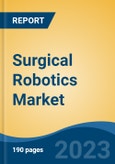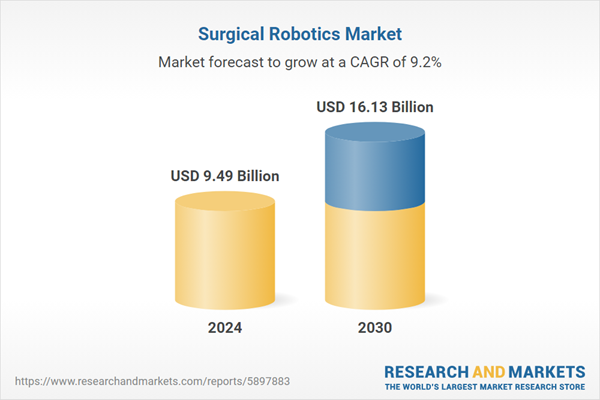Speak directly to the analyst to clarify any post sales queries you may have.
10% Free customizationThis report comes with 10% free customization, enabling you to add data that meets your specific business needs.
There was a growing demand for minimally invasive surgical procedures due to their associated benefits, such as shorter recovery times, reduced pain, and smaller incisions. Surgical robots enable surgeons to perform MIS with greater precision, contributing to their adoption. Surgical robots offer enhanced precision and accuracy compared to traditional surgical techniques. These qualities were particularly important for complex and delicate procedures, driving the adoption of robotic-assisted surgery.
The global aging population was increasing, leading to a higher demand for surgical procedures. Surgical robots were seen to address the healthcare needs of an aging demographic. Patients increasingly sought less invasive surgical options. Surgical robots allow for smaller incisions, reducing scarring and postoperative discomfort, which was a major driver of adoption. Surgical robots were being adopted in a wider range of medical specialties, including urology, gynecology, orthopedics, and cardiothoracic surgery.
This expansion into new areas increased the market's growth potential. Surgical robots were associated with improved surgical outcomes, including reduced complications and faster patient recovery. These outcomes were compelling factors for both surgeons and patients. Advancements in telecommunications technology allowed for telemedicine and remote surgery applications. Surgical robots enabled surgeons to perform procedures on patients located at a distance, expanding access to specialized care.
Key Market Drivers
Growing Geriatric Population and Chronic Disease Burden
The growing geriatric population and the rising prevalence of chronic diseases are two of the most significant macro-level drivers accelerating the growth of the Global Surgical Robotics Market. These trends are fundamentally reshaping healthcare demand, procedure volumes, and clinical expectations positioning surgical robotics as a critical solution for high-precision, outcome-oriented surgical interventions. Globally, populations are aging at an unprecedented rate. According to the World Population Prospects 2024, the global population is projected to continue expanding for the next five to six decades, reaching a peak of approximately 10.3 billion by the mid-2080s, up from 8.2 billion in 2024.This growth trajectory is then expected to reverse gradually, with the population declining slightly to around 10.2 billion by the year 2100. This demographic shift is directly associated with a higher incidence of age-related degenerative conditions, such as: Orthopedic disorders (e.g., osteoarthritis, spinal degeneration), Cardiovascular diseases, Urological conditions, Oncological complications. As the elderly increasingly require complex, high-risk surgical procedures, surgical robotics offers a distinct advantage by enabling minimally invasive, highly controlled interventions that reduce physiological stress and lower post-operative complications key considerations in managing aging patients.
In parallel, the global burden of chronic non-communicable diseases (NCDs) such as cancer, diabetes, and cardiovascular illnesses is rising steadily. According to the World Health Organization, NCDs account for approximately 71% of all global deaths, many of which involve conditions that eventually require surgical intervention. Surgical robots are increasingly used in treating these conditions, particularly in: Robotic-assisted prostatectomies, minimally invasive cardiac valve repairs, Lung and colorectal cancer resections, Spine and joint surgeries for degenerative diseases. Their ability to enhance surgical precision, reduce intraoperative risks, and improve post-operative recovery is making them a preferred solution in managing chronic diseases surgically, especially in high-volume centers and tertiary care hospitals.
Key Market Challenges
Cost of Maintenance and Upgrades
Acquiring a surgical robotic system is a significant upfront investment for hospitals and healthcare facilities. However, this initial purchase is only the beginning of the financial commitment. Surgical robots require regular maintenance to ensure they function correctly and safely. Maintenance involves servicing, calibrating, and repairing components. Maintenance contracts with manufacturers or third-party service providers incur costs. The software that controls surgical robots needs to be regularly updated to improve functionality, address bugs, and ensure compatibility with other systems. These updates come with associated costs.Instruments and accessories used with surgical robots may need to be replaced or refurbished periodically due to wear and tear. These costs can add up over time. As technology advances, healthcare institutions may need to upgrade their existing robotic systems to stay competitive or take advantage of new features. Upgrades can be expensive and require additional investment. Surgical teams must undergo ongoing training and recertification to maintain their proficiency in using robotic systems. Training programs have associated costs, including instructor fees and equipment usage fees. When a surgical robot is taken offline for maintenance or upgrades, it can result in downtime for the operating room. This downtime can lead to revenue loss for healthcare facilities.
Key Market Trends
Miniaturization
Miniaturized surgical robots allow for even smaller incisions, contributing to less invasive procedures. Smaller incisions are associated with reduced postoperative pain, shorter hospital stays, and quicker recovery times. Smaller robotic instruments can navigate through tight spaces within the body more easily, making them suitable for procedures in anatomically challenging areas. Miniaturized robotic systems can be used for a broader range of procedures across various medical specialties, including those that involve delicate tissues or structures. Miniaturized robotic systems are particularly useful in pediatric surgery, where the size and scale of traditional robotic systems may not be suitable for young patients.Some miniaturized robotic systems are designed for single-port access, allowing surgeons to perform surgeries through a single incision. This approach further reduces scarring and trauma to the patient. Smaller robotic systems are well-suited for use in ambulatory surgery centers, which can provide more cost-effective and convenient options for patients. Miniaturization can lead to cost savings in terms of equipment size, maintenance, and storage, making surgical robotics more accessible to a wider range of healthcare facilities. Smaller robotic systems may have simpler set-up and installation requirements, which can reduce the time needed to prepare for surgery.
Key Market Players
- Asensus Surgical, Inc.
- Siemens Healthineers AG
- Brainlab AG
- CMR Surgical Ltd.
- Curexo, Inc.
- Stryker
- Globus Medical, Inc.
- Smith & Nephew plc
- Intuitive Surgical, Inc.
- Johnson & Johnson
- Kinova inc.
- Medtronic plc
Report Scope:
In this report, the Global Surgical Robotics Market has been segmented into the following categories, in addition to the industry trends which have also been detailed below:Surgical Robotics Market, By Type:
- Surgical Systems
- Instruments and Accessories
- Services
Surgical Robotics Market, By Application:
- General Surgery
- Urology Surgery
- Gynecology Surgery
- Orthopedic Surgery
- Cardiology Surgery
- Head and Neck (including Neurology) Surgery
- Others
Surgical Robotics Market, By End User:
- Hospitals
- Ambulatory Surgery Centers
- Others
Surgical Robotics Market, By region:
- North America
- United States
- Canada
- Mexico
- Asia-Pacific
- China
- India
- South Korea
- Australia
- Japan
- Europe
- Germany
- France
- United Kingdom
- Spain
- Italy
- South America
- Brazil
- Argentina
- Colombia
- Middle East & Africa
- South Africa
- Saudi Arabia
- UAE
Competitive Landscape
Company Profiles: Detailed analysis of the major companies present in the Global Surgical Robotics Market.Available Customizations:
With the given market data, the publisher offers customizations according to a company's specific needs. The following customization options are available for the report.Company Information
- Detailed analysis and profiling of additional market players (up to five).
This product will be delivered within 1-3 business days.
Table of Contents
Companies Mentioned
- Asensus Surgical, Inc.
- Siemens Healthineers AG
- Brainlab AG
- CMR Surgical Ltd.
- Curexo, Inc.
- Stryker
- Globus Medical, Inc.
- Smith & Nephew plc
- Intuitive Surgical, Inc.
- Johnson & Johnson
- Kinova inc.
- Medtronic plc
Table Information
| Report Attribute | Details |
|---|---|
| No. of Pages | 182 |
| Published | April 2025 |
| Forecast Period | 2024 - 2030 |
| Estimated Market Value ( USD | $ 9.49 Billion |
| Forecasted Market Value ( USD | $ 16.13 Billion |
| Compound Annual Growth Rate | 9.2% |
| Regions Covered | Global |
| No. of Companies Mentioned | 12 |









